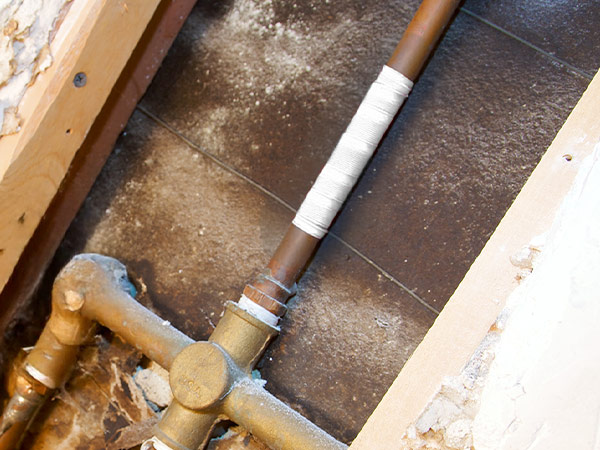

Don’t Panic! Here’s What to Do for a Burst Pipe
A burst pipe is never something a homeowner wants to deal with, but old pipes, a cold snap, or even high water pressure increases their likelihood. There’s no need to panic! Follow our guide to fix a burst pipe. Plus, we’ve got steps you can take today to prevent gushing water in your bathroom or anywhere else.
Signs of a Burst Pipe
There are many situations that can cause a burst pipe. The most common are frozen pipes, but others include rogue tree roots moving close to a buried outdoor pipe, corrosion of old pipes, clogs, hard water, shifting soil or foundations, high water pressure, accidental damage, or poor installation.
A burst pipe is easier to detect than a slow leak. Slow leaks can be caused by the same situations and can eventually become a burst pipe if not dealt with quickly. If you have a burst pipe you might hear or see:
- Pipe noises in the walls that are new or water sounds where you haven’t heard them before.
- A sharp, unexplained increase in your water bill.
- Water pressure problems like a slow trickle in your shower.
- Puddles of water. These can even be in your yard.
- Stains on your walls or ceilings that get bigger over a short period of time.
- Discolored water like a copper color or a sudden funky smell.
Pipes most likely to burst include:
- Pipe connected to the main water supply
- Pipes exposed to excessive cold or heat
- Pipes near tree roots
How to Deal with a Burst Pipe
Whether you have a flooded laundry room or an unwanted pool in your backyard, take these next important steps:
- Don't panic! Turn off the water supply. Shut the water off at the main water shut-off valve. This is typically near where the main water line connects to your house and could be in the front yard near the curb, an exterior wall, the garage or utility space, or under a crawl space. After locating the valve, turn it clockwise. You may need a wrench if it’s hard to turn.
- Relieve built-up pressure. Open all sinks and other faucets to release any built-up pressure in the pipes. Turn on both hot and cold taps and let them flow until all water has been drained. Built-up pressure can cause another burst pipe.
- Soak up water. Grab towels (this is a job for those big beach towels) and start soaking up pooled water. Water damage can happen on hardwood floors, baseboards, and drywall. If not dried out completely, this can cause rot and warp. If there’s tons of water, use a wet/dry vacuum. If the burst pipe is outside, you might be able to let it dry or help drain the water by using buckets to haul it away.
- Find the source of the leak. Some burst pipes are obvious. Some require a bit of detective work. If you suspect the burst pipe is inside a wall, you can cut into the drywall. Use a stud finder and utility knife/drywall saw. Cut a neat square in between the studs where you suspect the leak may be. If you find the leak, leave the studs exposed to dry and for the plumber to work. If the area is small enough, a drywall patch can be used after repairs.
- Call a plumber. Repairing a leak is a big job and is best left to a professional. Take note of the damage and give as much information as possible. This will also come in handy when discussing repairs with your home insurance company if the leak/damage is large enough.


Temporary Repairs
While permanent repairs should be made by a professional, temporary repairs can be made to prevent further water damage, if needed. Here are a few options:
- Epoxy putty. If the hole isn’t larger than a dime, apply epoxy putty around the damaged area. This is a very temporary fix and not designed to withstand water pressure but to minimize any leftover water leaks. Another quick fix is silicone tape wrapped around the damaged area.
- Clamps. Pipe clamps are simple to use. Secure the clamp around the damaged area and tighten to create a seal.
- Pipe repair casts. For a stronger seal, use a pipe repair cast over epoxy putty. Wrap the fiberglass wrap over the epoxy and let it harden.
How to Avoid a Burst Pipe
Prevention goes a long way when it comes to preventing a burst pipe. Here’s what you can do today:
- Insulate pipes during a freeze. Water expands when it freezes and can cause cracked and burst pipes. Follow our guide here on getting your home ready for a freeze. After a freeze, inspect your pipes for signs of stress.
- Maintain proper water pressure. The correct water pressure and flow not only saves you water but keeps your pipes in good condition. Read more about faucet flow rates.
- Repair leaks quickly. Small drips and leaks may not require the same amount of urgency a large break does, but it’s important to fix them as soon as possible. Continuous water flow through a small leak can grow to a burst pipe.
From Plumbing Pipes to Advice
Need a quick solution or preventative measures? Stop by your local McCoy’s to stock up before the next freeze or get a pipe repair cast to have on hand. We’re always ready to help and swap plumbing stories—we’re not shy!
